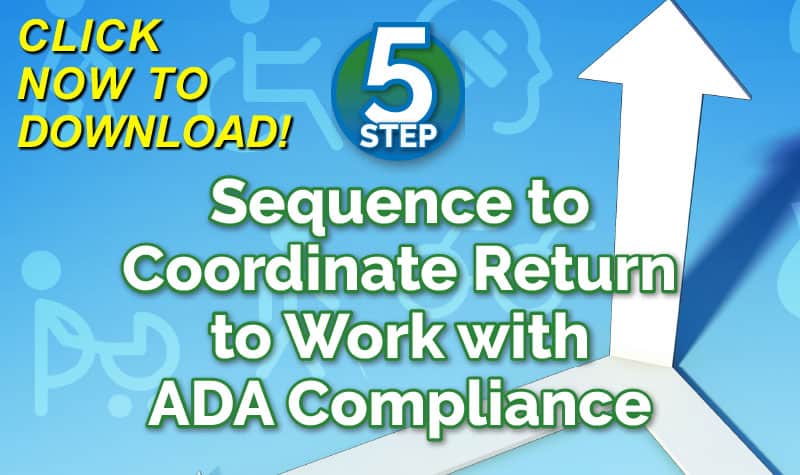
This post is one of a series as a follow up to training:
- ADA – If light duty cannot be accommodated, should FMLA run concurrently?
- ADA – Do All Work Comp Injuries Fall Under the Americans with Disabilities Act Amendments Act (ADAAA)?
- ADA – Is it against the law not to hire a person with a disability for a physical position?
A prior training on Return to Work and the ADA initiated the following questions:
- ADA – Questions on Temporary and Permanent Restrictions
- ADA – Reasonable Accommodation And Workers Comp Questions Answered
- ADA – Ensure Interactive Process Compliance, And Other Questions Answered
- ADA – What Happens When An Employee Opposes Return To Work?
- ADA – If No Light Duty Is Available, Can The Employer Terminate Employment?
Click Link to Access Free PDF Download
“5-Step Sequence to Coordinate Return-to-Work with ADA Compliance”
If a person with a disability applies for a physical position, is it against the law not to hire them?
Additional information: I work at a pharmaceutical packaging plant. The line operator job tasks are physically demanding, they have to lift, bend, squat, etc.
The answer to this question depends on several factors. Some disabilities will not affect the ability to do these things (e.g., someone with a psychiatric disability may be perfectly able to do this). Some people with disabilities might be affected, but because their condition is under control it wouldn’t actually interfere (e.g., epilepsy). In some cases, it will affect the ability to do the job, but a reasonable accommodation would overcome the difficulty. (Without knowing the details, it’s hard to come up with a realistic example of this. But perhaps a modified workstation would be an example.)
The employer must consider the possibility of reasonable accommodation before rejecting the individual. However, if the individual could not accomplish what he or she is required to accomplish even with a reasonable accommodation (or if all effective reasonable accommodations would cause undue hardship) then he or she is not qualified and may be rejected.
When we do the interactive process, when and how do we coordinate the workers’ compensation carrier/administrator?
Both the ADA law and workers’ compensation best practices run concurrently, and it is recommended to do everything required under both systems. Following workers comp cost containment best practices, good communication systems with your claims handler are an effective solution. Working with the adjuster in the ‘team approach’ to claims handling early in the process is recommended.
I encounter employers delaying the interactive process due to being afraid of a 132A violation.
Labor Code §132a states in pertinent part: “(1) Any employer who discharges, or threatens to discharge, or in any manner discriminates against any employee because he or she has filed or made known his or her intention to file a claim for compensation with his or her employer or an application for adjudication, or …Oct 23, 2016
It doesn’t make sense that a conflict would exist between Labor Code §132a and the interactive process. Labor Code §132a appears to be a state workers’ compensation law that states the employer is prohibited from discriminating on the basis of intent to file a workers’ comp claim. Engaging in the interactive process (e.g., asking whether the person could do the job with a reasonable accommodation) shouldn’t constitute discrimination. It’s not a threat to discharge or other form of discrimination. Also, the ADA is a federal law; doing what you are required to do under federal law can’t constitute a violation of state law.
Author:

Dr. Konopasky joined EEOC after receiving his J.D. from Stanford Law School. Prior to law school, he received his Ph.D. in philosophy from Princeton University, and served as an adjunct professor of philosophy at Rutgers University, Tulane University, and the University of New Orleans.
Author:

Contact: mstack@reduceyourworkerscomp.com.
Workers’ Comp Roundup Blog: https://blog.reduceyourworkerscomp.com/
©2019 Amaxx LLC. All rights reserved under International Copyright Law.
Do not use this information without independent verification. All state laws vary. You should consult with your insurance broker, attorney, or qualified professional.









